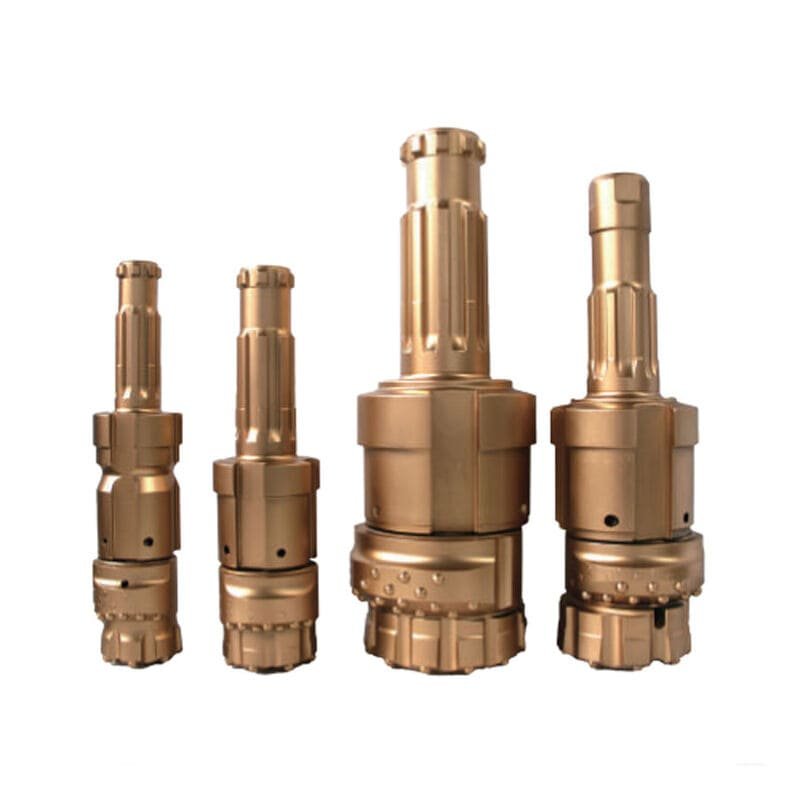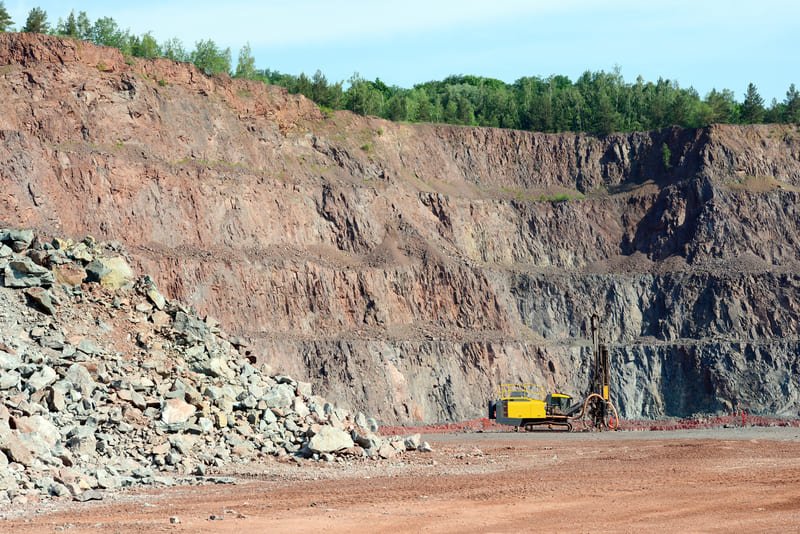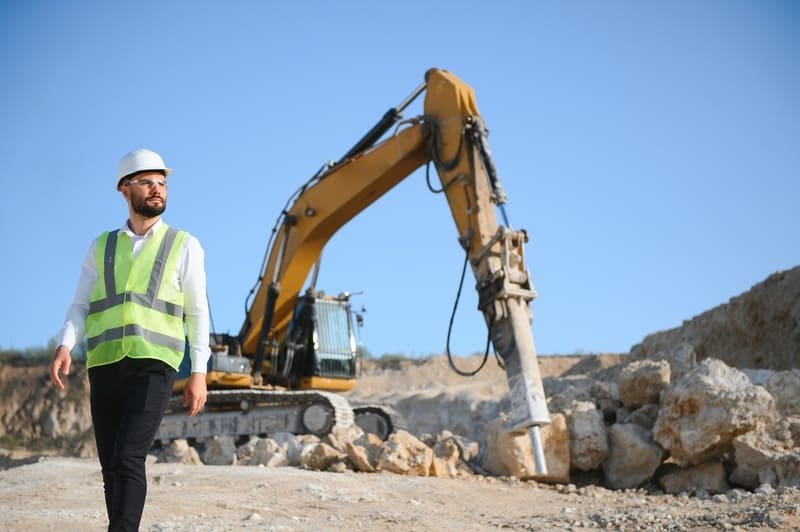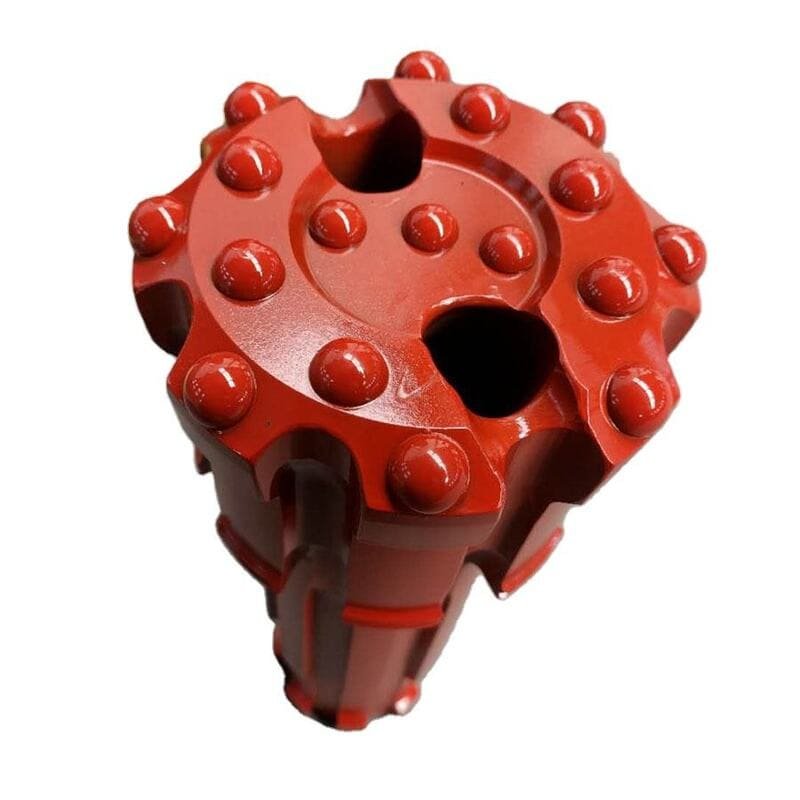Picture this: You're on a drilling project, and the last thing you need is a bit that can't handle the pressure.
DTH (Down-The-Hole) drill bits are incredibly durable due to their sturdy design and top-notch materials, excelling in tough rock conditions. They outlast rotary tricone, PDC, and drag bits by offering superior wear and impact resistance, making them a reliable choice for challenging drilling environments.
I remember the first time I faced the daunting task of choosing the right drill bit for a rocky terrain. It felt like choosing the right tool was half the battle won. DTH drill bits stood out because of their longer lifespan and amazing durability. They're designed to transfer energy directly to the rock face, which is a game changer when you're dealing with tough formations. It's like having a secret weapon in your drilling arsenal.
Beyond their resilience, DTH bits are crafted from high-quality materials like tungsten carbide. This gives them the edge when it comes to wear resistance. I realized that investing in such robust tools meant less downtime and more efficient operations. And let's not forget the smart design that allows them to dissipate heat effectively, preventing those dreaded mid-operation failures due to overheating.
Comparing them to other types like rotary tricone or PDC bits, DTH bits really shine in hard rock environments. They penetrate faster and last longer, saving time and money—two things you can never have enough of on a project. For anyone tackling challenging drilling conditions, understanding these advantages can make all the difference in selecting the right equipment.
DTH bits last longer than rotary tricone bits in hard rocks.True
DTH bits have superior durability in hard rock formations compared to tricone bits.
PDC bits are more durable than DTH bits in all conditions.False
PDC bits wear quickly in very hard, abrasive rocks compared to DTH bits.
Why Are DTH Drill Bits More Durable Than Rotary Tricone Bits?
Every time I face tough drilling conditions, I find myself reaching for DTH drill bits. But what makes them such a powerhouse compared to rotary tricone bits?
DTH drill bits are more durable due to their robust design, superior material quality, and efficient heat dissipation. These features allow them to maintain effectiveness longer in hard rock formations compared to rotary tricone bits.

Design and Impact Delivery
Imagine you're trying to break a stubborn rock with a hammer. Now, picture the energy directly transferring to the rock face, like a powerful punch—this is what DTH (Down-The-Hole) drill bits do. I remember my first project using these bits; the way they delivered impact energy right where it mattered was like watching an artist at work. The energy loss was minimal, a stark contrast to rotary tricone bits that spread their energy over larger areas with less precision. This efficient energy transfer not only accelerated the process but also reduced wear and tear, making DTH bits my go-to choice for challenging projects.
The focused energy delivery of DTH bits not only increases penetration rates but also minimizes wear and tear, leading to longer operational life1 in demanding environments.
Material Composition
The secret sauce in DTH drill bits is often high-quality materials like tungsten carbide. I recall a conversation with a colleague who was amazed at how DTH bits maintained their sharpness and effectiveness even after weeks of drilling in harsh conditions. Rotary tricone bits, on the other hand, would frequently need replacements due to material degradation.
Knowing that my DTH bits are made of such sturdy stuff gives me peace of mind, especially when tackling hard rock formations. The composition ensures they remain sharp and effective for extended periods, reducing the need for frequent replacements.
Heat Dissipation
One of the biggest challenges I've faced during drilling operations is managing the heat generated by friction. DTH drill bits excel in this area with their clever design that circulates air or fluid through the hammer and bit. It felt like magic the first time I saw how efficiently it kept the bit cool, preventing overheating and premature wear.
Unlike rotary tricone bits, which struggle with heat dissipation, DTH systems facilitate cooling and prevent overheating effectively.
Resistance to Abrasive Conditions
In my line of work, abrasive conditions are just part of the package. But DTH drill bits handle these conditions with ease. Their robust build and advanced design, including the strategic arrangement of carbide inserts and flushing holes, make them resilient against abrasive wear.
I’ve seen firsthand how this resistance saves time and costs on projects involving tough geological formations. It's like having a trusty sidekick that never lets you down when the going gets tough.
This resistance is crucial for maintaining cost-effectiveness and operational efficiency in projects involving abrasive rock types2.
DTH bits have better heat dissipation than tricone bits.True
DTH bits' air or fluid circulation aids in cooling, enhancing durability.
DTH drill bits wear faster than PDC bits in hard rocks.False
DTH bits excel in hard, abrasive rocks where PDCs may wear quickly.
How Do DTH Drill Bits Perform in Abrasive Conditions Compared to PDC Bits?
Ever wondered how different drill bits handle the toughest conditions? Let me take you through a journey of discovery as we explore the rugged world of DTH and PDC drill bits.
From my experience, DTH drill bits shine in abrasive conditions thanks to their sturdy design and direct impact action, often outlasting PDC bits, which can wear down quicker when facing similar challenges.

Understanding DTH Drill Bits in Abrasive Conditions
When I first started working with DTH (Down-The-Hole) drill bits, I was amazed by their ability to deliver powerful energy straight to the rock face. Their robust construction, often featuring tungsten carbide3 inserts, ensures they hold up remarkably well against wear. I’ve seen them keep cutting like champs long after other bits have faltered, which is crucial when you’re drilling for extended periods. Plus, the way they manage heat is incredible—no more worrying about them overheating and losing their edge in the middle of a job.
Performance of PDC Bits
On the flip side, PDC (Polycrystalline Diamond Compact) bits have their own story. They’re fantastic in softer formations and can breeze through less abrasive rocks with speed and efficiency. But, throw them into a hard, abrasive environment, and they start to struggle. I recall a project where the diamond cutters on our PDC bits wore down faster than expected, slowing our progress considerably. It taught me a valuable lesson about matching the bit to the terrain.
Comparing Durability and Efficiency
So, how do you choose between these two? It all comes down to understanding your operational parameters4. For DTH bits, it’s about getting the air pressure and rotation speed just right. With PDC bits, you need to be mindful of the weight on bit and rotation speed to avoid wearing them out too quickly. It's a balancing act that I’ve learned through trial and error on various projects. Each geological formation has its quirks, and aligning your choice with those specifics is key.
Insights from Industry Applications
In my experience across mining and construction projects, I’ve often seen DTH bits being the go-to for abrasive conditions. Their durability in tough terrains makes them an industry favorite. However, for projects where speed is of the essence and the terrain is forgiving, PDC bits steal the show with their precision. Making the right choice involves a bit of foresight and understanding of the geological landscape you're working with.
By carefully considering the needs of each drilling project and what the ground beneath you is made of, you can decide which bit will bring about the best performance. It's not just about cost or efficiency—it's about making informed decisions that lead to success.
DTH bits last longer than PDC bits in abrasive rocks.True
DTH bits are more durable in abrasive conditions due to superior material and design.
PDC bits outperform DTH bits in hard rock formations.False
DTH bits are better suited for hard rock due to their impact resistance and design.
Why Do I Prefer DTH Bits Over Drag Bits for Hard Rock Drilling?
Imagine being in the middle of a tough drilling project, staring at a stubborn piece of hard rock. That's when DTH bits really shine.
DTH bits are my go-to for hard rock drilling because they offer unmatched durability, faster penetration rates, and can handle high-frequency impacts with ease. These features make them far more efficient and cost-effective than drag bits when facing tough geological challenges.

Durability and Wear Resistance
One of the key reasons DTH bits are favored over drag bits is their remarkable durability. Constructed from high-quality materials like tungsten carbide, DTH bits offer excellent wear resistance. This allows them to maintain cutting effectiveness in abrasive conditions. In contrast, drag bits often wear out faster due to continuous scraping against hard surfaces.
Efficient Energy Transfer
DTH drilling technology involves a hammer that delivers energy directly to the bit, resulting in efficient rock penetration. This direct impact mechanism improves penetration rates5 significantly when compared to drag bits, which rely on rotational force alone. The ability to penetrate rock quickly not only saves time but also reduces operational costs.
High-Frequency Impact Resistance
The design of DTH bits enables them to endure high-frequency impacts, making them ideal for percussive drilling applications. This resilience is crucial when dealing with hard rock formations that can cause standard bits to fail prematurely. On the other hand, drag bits lack this robustness and are more prone to damage under similar conditions.
Heat Dissipation Features
Another advantage of DTH bits is their superior heat dissipation capability. The air or fluid circulation within the DTH system helps prevent overheating, a common issue in hard rock drilling that can lead to premature bit wear. Drag bits, without such a feature, are more susceptible to heat-related damage during prolonged drilling sessions.
Versatility in Challenging Conditions
In environments where geological conditions vary, the versatile design6 of DTH bits allows them to adapt better than drag bits. This adaptability enhances their performance across different rock types, making them a preferred choice for complex projects requiring precision and efficiency.
DTH bits have longer lifespans than rotary tricone bits.True
DTH bits are more durable in hard rock, outperforming tricone bits.
Drag bits last longer than DTH bits in hard rock.False
DTH bits are designed for durability in hard rock, unlike drag bits.
How Can I Maximize the Lifespan of My DTH Drill Bits?
Ever wondered how to squeeze the most out of your DTH drill bits?
To maximize the lifespan of DTH drill bits, focus on rock characteristics, operating parameters, bit design, and regular maintenance. These factors, when optimized, can significantly enhance bit durability and performance.

Understanding Rock Characteristics
I remember the first time I encountered an unexpectedly hard rock formation during a project. My drill bit wore out faster than I could've imagined. It taught me the importance of understanding the type of rock I was dealing with. Hard and abrasive rocks are particularly tough on DTH drill bits. By knowing the geological conditions ahead of time, I could choose a bit design that was up to the task. For instance, opting for bits with tungsten carbide inserts helped me extend their life considerably in high-abrasion environments.
Optimizing Operating Parameters
I once learned the hard way how critical it is to get the operational parameters just right. A colleague had shared a story about how tweaking air pressure, rotation speed, and feed force had made a world of difference for him. Properly adjusted air pressure ensures efficient debris removal and cooling, while the right rotation speed keeps the cutting edge sharp. Matching feed force with rock hardness can prevent undue stress on the bit, which is something I wish I had known earlier. Trust me, following these steps can significantly boost your drill bit lifespan. Consulting industry standards7 for exact parameter settings can also be a game-changer.
Importance of Bit Design
The design aspect of DTH drill bits is often overlooked but is incredibly crucial. I discovered this when experimenting with different designs during a challenging project. The layout of carbide inserts and flushing holes can make a significant difference. Bits with balanced insert distribution and effective flushing capacity help in achieving even wear and efficient debris clearance. These features prevent overheating and prolong the life of the bits. Exploring innovative bit designs8 opened my eyes to new possibilities and performance improvements.
Regular Maintenance Practices
Regular maintenance wasn't something I always prioritized until I learned its true value. Routine checks for wear patterns or damage have saved me from costly replacements down the line. Re-sharpening or replacing worn inserts at the right time can keep things running smoothly. Plus, handling and storing bits properly prevents accidental damage. Developing a comprehensive maintenance schedule9 not only extends the life of the drill bits but also enhances overall efficiency in my projects.
DTH bits have longer lifespan than rotary tricone bits.True
DTH bits are designed to last longer in hard rock formations than tricone bits.
PDC bits outperform DTH in very hard, abrasive rocks.False
DTH bits generally perform better in hard, abrasive rocks compared to PDC bits.
Conclusion
DTH drill bits excel in durability, outperforming rotary tricone and PDC bits in hard rock conditions due to superior materials, efficient energy transfer, and effective heat dissipation.
-
Explore reasons why DTH bits outlast others in tough conditions. ↩
-
Learn how DTH bits handle abrasive environments effectively. ↩
-
Discover why tungsten carbide enhances drill bit durability. ↩
-
Learn how operational settings impact drill bit effectiveness. ↩
-
Learn about the engineering behind faster penetration with DTH bits. ↩
-
Discover how DTH bits adapt to different rock formations effectively. ↩
-
Ensure optimal settings for air pressure and rotation speed. ↩
-
Discover new designs that enhance durability and efficiency. ↩
-
Implement a schedule to prolong drill bit life and efficiency. ↩








